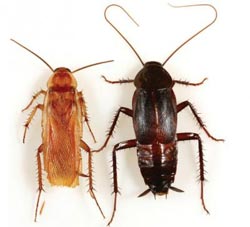The invasive Turkestan cockroach is displacing the oriental cockroach in the southwestern US

Adult males of the Turkestan cockroach, Blatta lateralis, (left) and the oriental cockroach, Blatta orientalis (right) are shown.<br><br>Credit: Entomological Society of America<br>
In 1978, the Turkestan cockroach was first reported at Sharpe Army Depot in Lathrope, CA, and it is now widely distributed throughout California and urban centers of the southwest.
This species is widely available for purchase on the Internet by animal breeders needing live insects. They are especially popular among reptile breeders because they are easily maintained in the lab, unable to climb smooth surfaces, breed in large numbers, and easy to handle.
However, even though Turkestan cockroaches are now widespread and readily available on the Internet, there is little information on their biology. In a new article in the Journal of Economic Entomology called “Life History and Biology of the Invasive Turkestan Cockroach (Dictyoptera: Blattidae),” the authors describe its life history and they compares this information with the closely related oriental cockroach.
Two parameters that might contribute to the success of Turkestan cockroaches compared with oriental cockroaches, the authors write, are that the developmental period of the nymphs of Turkestan cockroaches are shorter, and adult female Turkestan cockroaches produce considerably more eggs than do oriental cockroaches.
They also have a more rapid life cycle than the oriental cockroach, allowing them to become adults after five molts, whereas oriental cockroaches require between 7 and 10 molts.
“It will be interesting to follow the spread of the Turkestan cockroach in the United States,” the authors write. “This may be the first time that an invasive urban pest species is widely distributed via the Internet and through the sale of live insects.”
Members of the media who would like an advanced copy of the article should write to rlevine@entsoc.org or call 301-731-4535, ext 3009.
The Journal of Economic Entomology is published by the Entomological Society of America, the largest organization in the world serving the professional and scientific needs of entomologists and people in related disciplines. Founded in 1889, ESA today has more than 6,500 members affiliated with educational institutions, health agencies, private industry, and government. Members are researchers, teachers, extension service personnel, administrators, marketing representatives, research technicians, consultants, students, and hobbyists. For more information, visit http://www.entsoc.org.
Media Contact
More Information:
http://www.entsoc.orgAll latest news from the category: Ecology, The Environment and Conservation
This complex theme deals primarily with interactions between organisms and the environmental factors that impact them, but to a greater extent between individual inanimate environmental factors.
innovations-report offers informative reports and articles on topics such as climate protection, landscape conservation, ecological systems, wildlife and nature parks and ecosystem efficiency and balance.
Newest articles

Making diamonds at ambient pressure
Scientists develop novel liquid metal alloy system to synthesize diamond under moderate conditions. Did you know that 99% of synthetic diamonds are currently produced using high-pressure and high-temperature (HPHT) methods?[2]…

Eruption of mega-magnetic star lights up nearby galaxy
Thanks to ESA satellites, an international team including UNIGE researchers has detected a giant eruption coming from a magnetar, an extremely magnetic neutron star. While ESA’s satellite INTEGRAL was observing…

Solving the riddle of the sphingolipids in coronary artery disease
Weill Cornell Medicine investigators have uncovered a way to unleash in blood vessels the protective effects of a type of fat-related molecule known as a sphingolipid, suggesting a promising new…





















